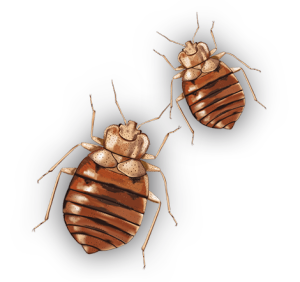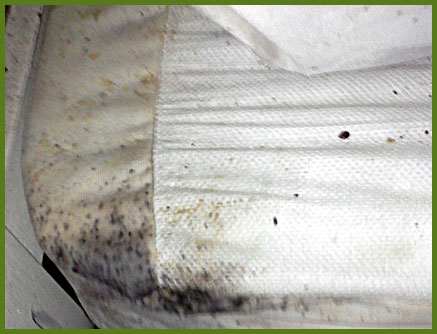 What are bed bugs?
What are bed bugs?
Bed bugs (Cimex lectularius) are small, flat, parasitic insects that feed solely on the blood of people and animals while they sleep. Bed bugs are reddish-brown in color, wingless, range from 1mm to 7mm (roughly the size of Lincoln’s head on a penny), and can live several months without a blood meal.
Where are bed bugs found?
Bed bugs are found across the globe. Although their presence has traditionally been seen as a problem in developing countries, it has recently been spreading rapidly in parts of the United States, Canada, the United Kingdom, and other parts of Europe. Bed bugs have been found in five-star hotels and resorts, and their presence is not determined by the cleanliness of the living conditions where they are found.
Bed bug infestations usually occur in or near the areas where people sleep. These areas include apartments, shelters, rooming houses, hotels, cruise ships, buses, trains, and dorm rooms. They hide during the day in places such as seams of mattresses, box springs, bed frames, headboards, dresser tables, cracks or crevices, behind wallpaper, or any other clutter or objects around a bed. Bed bugs have been proven to be able to travel over 100 feet in a night but tend to live within 8 feet of where people sleep.
Do bed bugs spread disease?
Bed bugs should not be considered a medical or public health hazard. They are not known to spread disease. Bed bugs can, however, be an annoyance because their presence may cause itching and loss of sleep. Sometimes the itching can lead to excessive scratching that can increase the chance of a secondary skin infection.
What health risks do bed bugs pose?
A bed bug bite affects each person differently. Bite responses can range from an absence of any physical signs of the bite to a small bite mark to a serious allergic reaction. Bed bugs are not considered to be dangerous, but an allergic reaction to several bites may need medical attention.
What are the signs and symptoms of a bed bug infestation?
One of the easiest ways to identify a bed bug infestation is by the tell-tale bite marks that appear on the face, neck, arms, hands, or other body parts during sleep. However, these bite marks may take as long as 14 days to develop in some people, so it is important to look for other clues when determining if bed bugs have infested an area. These signs include:
- The bed bugs’ exoskeletons after molting.
- Bed bugs in the fold of mattresses and sheets.
- Rust–colored blood spots due to the blood-filled fecal material they excrete on the mattress or nearby furniture.
- A sweet, musty odor.
How do I know if I’ve been bitten by a bed bug?
It is hard to tell if you’ve been bitten by a bed bug unless you find bed bugs or signs of infestation. When bed bugs bite, they inject an anesthetic and an anticoagulant that prevents a person from realizing they are being bitten. Most people do not realize they have been bitten until bite marks appear anywhere from one to several days after the initial bite. The bite marks are similar to that of a mosquito or a flea—a slightly swollen and red area that may itch and be irritating. The bite marks may be random or appear in a straight line. Other symptoms of bed bug bites include insomnia, anxiety, and skin problems that arise from profuse scratching of the bite marks.
Because bed bug bites affect everyone differently, some people may have no reaction and will not develop bite marks or any other visible signs of being bitten. Other people may be allergic to the bed bugs and can react adversely to the bites. These allergic symptoms can include enlarged bite marks, painful swelling at the bite site and, on rare occasions, anaphylaxis.
How did I get bed bugs?
Bed bugs are experts at hiding. Their slim, flat bodies allow them to fit into the smallest of spaces and stay there for long periods of time, even without a blood meal. Bed bugs are usually transported from place to place as people travel. The bed bugs travel in the seams and folds of luggage, overnight bags, folded clothes, bedding, furniture, and anywhere else where they can hide. Most people do not realize they are transporting stowaway bed bugs as they travel from location to location, infecting areas as they go.
Who is at risk for getting bed bugs?
Everyone is at risk for getting bed bugs when visiting an infected area. However, anyone who travels frequently and shares living and sleeping quarters where other people have previously slept has a higher risk of being bitten and/or spreading a bed bug infestation.
How are bed bugs treated and prevented?
Bed bug bites usually do not pose a serious medical threat. The best way to treat a bite is to avoid scratching the area, apply antiseptic creams or lotions, and take an antihistamine. Bed bug infestations are commonly treated by insecticide spraying or high heat treatments. If you suspect that you have an infestation, contact your landlord or a professional that is experienced with treating bed bugs. The best way to prevent bed bugs is regular inspection for the signs of an infestation.
Source: Centers for Disease Control and Prevention
Facts about bed bugs
-
Bed bugs can enter your home undetected through luggage, clothing, used beds and couches, and other items.
-
Bed bugs live solely on blood.
-
Bed bugs likely get their name from their habit of feeding on humans while they sleep in their beds.
-
Adult bed bugs can be smelly, with a “musty-sweetish” odor produced through glands on the lower side of the body.
-
Adult bed bugs are about the size of an apple seed (5-7 mm or 3/16–1/4 inch long).
-
Bed bug bites usually do not pose a serious medical threat.

Evidence of bed bug activity
